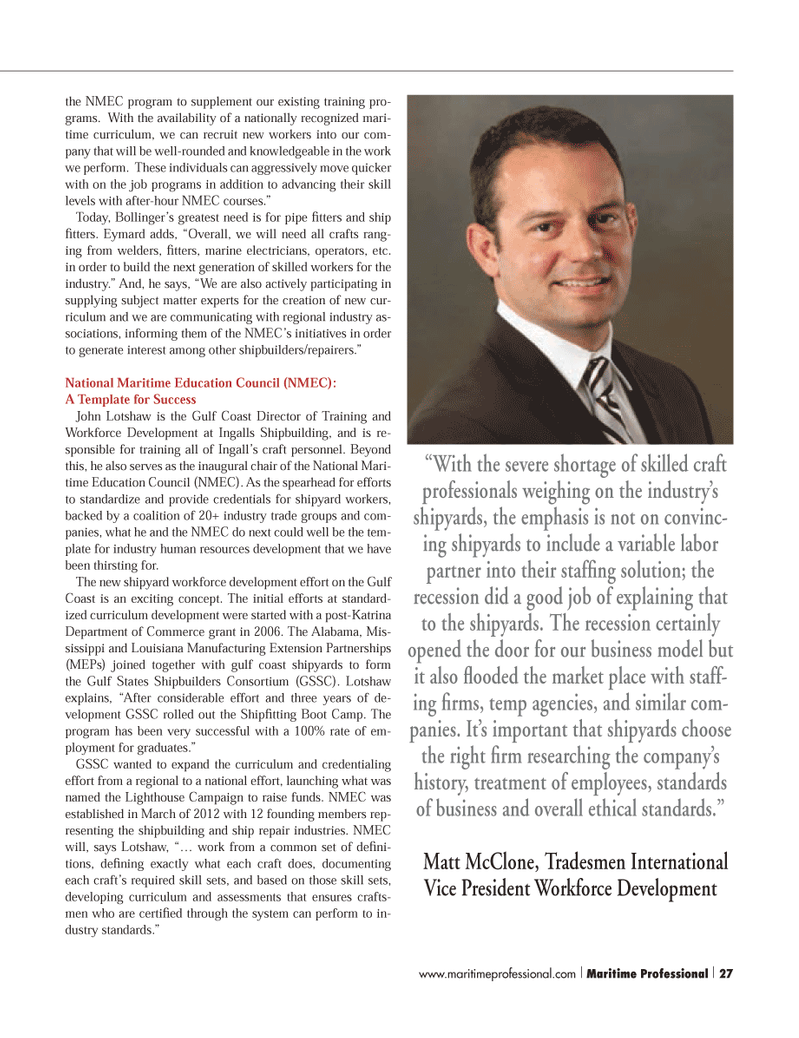
Page 27: of Maritime Logistics Professional Magazine (Q4 2013)
Shipbuilding, Repair
Read this page in Pdf, Flash or Html5 edition of Q4 2013 Maritime Logistics Professional Magazine
the NMEC program to supplement our existing training pro- grams. With the availability of a nationally recognized mari- time curriculum, we can recruit new workers into our com- pany that will be well-rounded and knowledgeable in the work we perform. These individuals can aggressively move quicker with on the job programs in addition to advancing their skill levels with after-hour NMEC courses.? Today, Bollinger?s greatest need is for pipe tters and ship tters. Eymard adds, ?Overall, we will need all crafts rang- ing from welders, tters, marine electricians, operators, etc. in order to build the next generation of skilled workers for the industry.? And, he says, ?We are also actively participating in supplying subject matter experts for the creation of new cur- riculum and we are communicating with regional industry as- sociations, informing them of the NMEC?s initiatives in order to generate interest among other shipbuilders/repairers.? National Maritime Education Council (NMEC): A T emplate for Success John Lotshaw is the Gulf Coast Director of Training and Workforce De velopment at Ingalls Shipbuilding, and is re- sponsible for training all of Ingall?s craft personnel. Beyond this, he also serves as the inaugural chair of the National Mari- time Education Council (NMEC). As the spearhead for efforts to standardize and provide credentials for shipyard workers, backed by a coalition of 20+ industry trade groups and com- panies, what he and the NMEC do next could well be the tem- plate for industry human resources development that we have been thirsting for. The new shipyard workforce development effort on the Gulf Coast is an exciting concept. The initial efforts at standard- ized curriculum development were started with a post-Katrina Department of Commerce grant in 2006. The Alabama, Mis- sissippi and Louisiana Manufacturing Extension Partnerships (MEPs) joined together with gulf coast shipyards to form the Gulf States Shipbuilders Consortium (GSSC). Lotshaw explains, ?After considerable effort and three years of de- velopment GSSC rolled out the Ship tting Boot Camp. The program has been very successful with a 100% rate of em- ployment for graduates.? GSSC wanted to expand the curriculum and credentialing effort from a regional to a national effort, launching what was named the Lighthouse Campaign to raise funds. NMEC was established in March of 2012 with 12 founding members rep-resenting the shipbuilding and ship repair industries. NMEC will, says Lotshaw, ?? work from a common set of de ni-tions, de ning exactly what each craft does, documenting each craft?s required skill sets, and based on those skill sets, developing curriculum and assessments that ensures crafts- men who are certi ed through the system can perform to in- dustry standards.? ?With the severe shortage of skilled craft professionals weighing on the industry?s shipyards, the emphasis is not on convinc- ing shipyards to include a variable labor partner into their staf ng solution; the recession did a good job of explaining that to the shipyards. The recession certainly opened the door for our business model but it also ooded the market place with staff- ing rms, temp agencies, and similar com- panies. It?s important that shipyards choose the right rm researching the company?s history, treatment of employees, standards of business and overall ethical standards.? Matt McClone, Tradesmen International Vice President Workforce Development www.maritimeprofessional.com | Maritime Professional | 27MP #4 18-33.indd 27MP #4 18-33.indd 2712/12/2013 3:15:38 PM12/12/2013 3:15:38 PM

 26
26

 28
28
